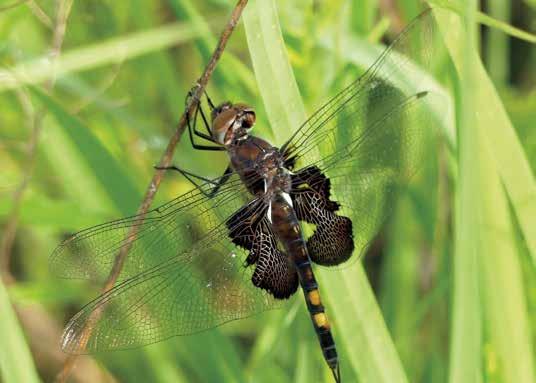Left: Black saddlebags dragonfly
natural chicago
Dragonflies & Nighthawks
Photo by Cindy Crosby.
FILL AUGUST SKIES by Sheryl DeVore
O
ne day in late August, Cindy Crosby stood on a bridge overlooking the Schulenberg Prairie at the Morton Arboretum. “I saw a vortex of glinting greens and blues,” says Crosby, author of the newly released Chasing Dragonflies. She was witnessing the migration of common green darner dragonflies. “I marvel at this storm of wings, this maelstrom of insects, all attuned to some wild desire,” she writes in her book. “The spectacle mostly goes unnoticed, although it’s likely been happening for hundreds of thousands of years.” Indeed, dragonflies have lived on the planet for 300 million years. Scientists first described migratory dragonflies in the late 1880s, and today believe this natural phenomenon occurs on every continent except Antarctica. 40
Chicago
NAChicago.com
Darners and Saddlebags “In the Chicago region, I’ve seen migration as early as mid-August and well into September,” says Crosby, who helps monitor dragonflies and damselflies for the Illinois Odonate (dragonflies and damselflies) Survey (IllinoisOdes.org) at Nachusa Grasslands (NachusaGrasslands.org) and the Morton Arboretum (MortonArb.org). Just a few of more than 100 species of dragonflies seen in Illinois are migratory. “The primary migrators I see are by far common green darners and black saddlebags. You’ll usually see a few variegated meadowhawks and wandering gliders mixed in.” Those that walk out onto a prairie or wetland, along the Lake Michigan shoreline or in their own yard during the evening
can look to the sky searching for migratory dragonflies. If the green darners come close enough, observers can note the green thorax of both sexes. Males have blue abdomens and females have brownish abdomens. These are large dragonflies, with a wingspread of about four inches and a length of three inches. Fewer numbers of black saddlebag dragonflies also fly south in fall. As this species’ name implies, they have a black saddle mark at the base of the hindwing. Females have a yellow spot toward the end of their abdomen. Although they don’t migrate in large numbers like the green darner, black saddlebags often can be seen flying overhead in ones, twos or small groups over the Chicago region. A good day to watch hawk migration is also a good day to search for migratory dragonflies, according to Cynthia Berger, author of Wild Guide: Dragonflies. “The movements of both groups are strongly influenced by the weather,” she writes. “Look for the mass movements just after a southbound cold front passes through the area. Like raptors, dragonflies depend on thermals—rising currents of warm air—to loft them high in the air up to the altitude where steady winds will speed them on their journey south.” Those that watch hawks at Illinois Beach State Park, in Zion, Fort Sheridan Forest Preserve, near Highwood, and the Greene Valley Forest Preserve Hawk Watch, in Naperville, often remark on the migratory dragonflies they see while docuBelow: Common green darner dragonfly
Photo by Bruce Marlin








